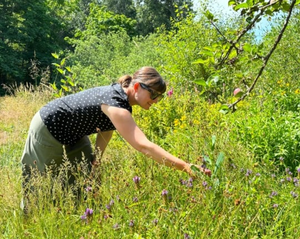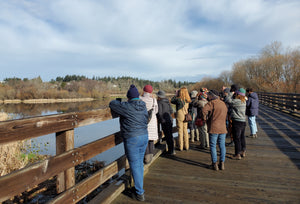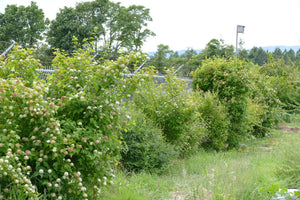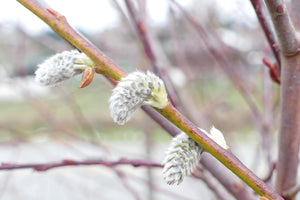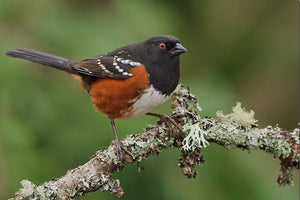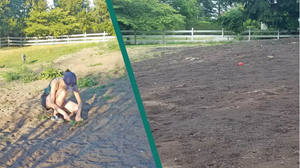The Weekly with Daly: Leafcutter Bees

The Weekly with Daly is a regular column about the musings of the nursery written by our in-house wildlife observer and passionate conservationist, Julia Daly.
Written July 29, 2021
I was admiring a patch of entire-leaved gumweed (Grindelia stricta) in my front yard yesterday when I noticed a bee approaching the side of an old whisky barrel planter. But this wasn’t just any bee on an ordinary pollen/nectar gathering mission: it had a rolled-up leaf tube in its grasp, and I watched in amazement as it slipped between two of the whisky barrel’s slats to place its precious cargo. It was a Western leafcutter bee (Megachile perihirta)! Gumweed flowers are absolute bee magnets, and while I see leafcutter bees visiting their flowers regularly, I was thrilled to see one building a nest in the habitat I created for them.
Native to western North America, western leafcutters are solitary bees (do not nest in a colony) in the family Megachilidae. Like other species of leafcutter bees, they collect pollen on their abdomens (so are often seen with yellow pollen covered “bellies”) and cut leaves to construct beautiful capsule-like brood chambers for their young. The females build each capsule by chewing oval-shaped leaf fragments from plants like fireweed, maples, and members of the rose family (they prefer thin, non-hairy leaves). Each leaf fragment is then rolled into a tube and placed inside a cavity, like a hollow plant stem, piece of rotting wood, or in the soil, and segmented into cells or “rooms” using smaller circular-shaped leaf disks – AMAZING! The females will keep adding cells until the cavity has been filled. In each cell, she lays an egg on top of a ball of nectar and pollen. After the eggs hatch into larvae, they feed on the food ball their mother left for them. Over the fall and winter, they transform into a pupa, then into adults that emerge the following spring to find a mate and start the lifecycle over again.
To attract western leafcutter bees, plant summer-flowering species like gumweed (Grindelia stricta or hirsutula), woolly sunflower (Eriophyllum lanatum), mountain sneezeweed (Helenium autumnale), and fireweed (Epilobium angustifolium). And don’t forget to include some suitable nest-building habitat, like hollow stems (e.g., from last year’s flowers), dead wood, and bare soil.
Take some time to observe and be inspired by nature today.
I hope you've enjoyed this Weekly with Daly!
Signing off,
Julia

Figure 1: Western leafcutter bee collecting pollen and nectar from Grindelia stricta.

Figure 2: Leafcutter bee nest accidentally unearthed from a potting soil pile at Satinflower Nurseries last summer. The egg chambers were then realigned and placed safely in a furrow underneath a flat piece of wood in a nearby plant bed.

Figure 3: Signs of leafcutter bee activity on fireweed (Epilobium angustifolium). Notice both the oval and circle-shaped cutouts for lining the tunnels and capping the cells.

Figure 4: Whisky barrel planter where Western leafcutter bee was seen building a nest!
- Satinflower Nurseries

